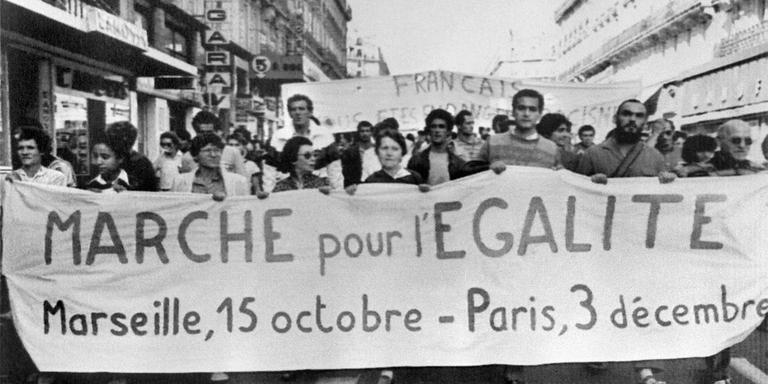


The central part played by women in the 1983 March for Equality in France
NewsThe March for Equality and Against Racism began in the Minguettes neighborhood on the outskirts of Lyon and set off from Marseilles on October 15, 1983. 100,000 people marched toward Paris.
"Tomorrow I'm leaving." Malika Boumediene still cannot believe she uttered this sentence to her mother one day in October 1983. At the age of 20, the shy young woman, who had never left the comforts of her family, suddenly announced that she wanted to leave their home in the rural department of Ardèche in southeast France. She wanted to join a collective march against racism that was passing through Saint-Vallier, on the other side of the Rhône River. Her mother was determined to dissuade her. "She was really against it. She was scared for me. But I packed my little bag and left the next day," recalled the 60-year-old care assistant, still amazed at her audacity.
In her living room on the second floor of a building overlooking a roundabout near Annonay in Ardèche, exhausted after a night on call, the mother of three revisited her past, leafing through a photo album. She conjured up her youthful face, her slightly sulky pout and the abundant curly hair that flashed above the banner of the small group on the road: "March for Equality and Against Racism."
Born to Algerian parents who came to France after the end of the Second World War, Boumedienne was part of the original organizers behind the 1983 march. "My mother was angry and wouldn't answer the phone when I called. But when the TV started talking about us, she began to accept it," she said. From around 20 participants at the outset, on October 15 in Marseille in southern France, they went to 100,000 at the finish line, on Saturday, December 3, at Place de la Bastille in central Paris. It was a communion of rare intensity. In the same year that Richard Attenborough's film celebrated Gandhi on cinema screens, these anonymous figures completed a peaceful march filled with hope, to denounce racist crimes, incessant police control and the feeling of rejection that weighed on second-generation North African immigrants. Among them, young women played a decisive, but little-known, role.
'New space of freedom'
Forty years on, Boumedienne takes no credit for her initiative, neither for the 1,500 kilometers she walked, nor for her presence in the small delegation received by former president François Mitterrand at the Elysée Palace. "When we were on the podium, at the end of [Junior Minister in charge of immigrant workers] Georgina Dufoix's speech, we learned that eight persons had been designated to meet the president. I was chosen. He spent five minutes talking to each of us. He wanted to know how we lived in our towns. He did the rounds with everyone and that was it," she said, unimpressed by the meeting.
You have 76% of this article left to read. The rest is for subscribers only.
